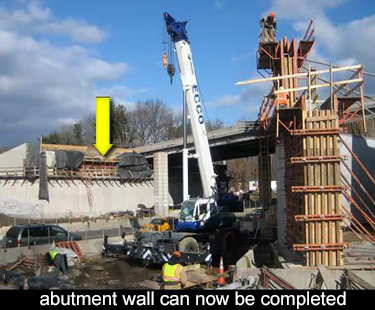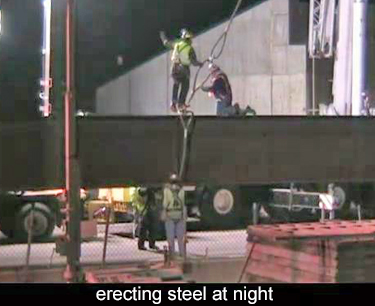The concrete deck has been removed . You can see how the abutment had been constructed right up to the underside of the concrete deck. Now, the existing steel can be removed, and the abutment construction can be completed. At the South abutment, the construction can also be completed, since the steel is gone. That will pave the way for erecting the new structural steel.
 Here's a view with the old steel removed, and the formwork is in place for the remainder of the abutment.
Here's a view with the old steel removed, and the formwork is in place for the remainder of the abutment.
 This is the setup for the steel erection. It takes place at night. They waited till about 10:00 pm. At that point, they could take the traffic on the roadway below and limit it to just a single lane and they would alternate the traffic in that single lane. When it was finally time to lift the piece of steel, which is illustrated in this photo, then the traffic would have to be shut down altogether until the piece was secured in place. I have some video showing the nighttime operation to erect the new steel.
This is the setup for the steel erection. It takes place at night. They waited till about 10:00 pm. At that point, they could take the traffic on the roadway below and limit it to just a single lane and they would alternate the traffic in that single lane. When it was finally time to lift the piece of steel, which is illustrated in this photo, then the traffic would have to be shut down altogether until the piece was secured in place. I have some video showing the nighttime operation to erect the new steel.
They've created a space for the crane, which will allow the crane to fully extend its outriggers and still allow one lane of traffic to squeeze by. This is making the most of the situation. The public is always allowed one lane, one direction at a time, because there was space available to do that. That is not always the case.
When the crane is in place, it needs to extend its outriggers. Because of the heavy loads involved, it places pads underneath the outriggers in order to distribute the load. It's not just the single pad. In this case it was two pads. First one went down seemed to be somewhat more flexible and the second one was rigid. You need to install eight of these pads before the crane is fully operational.
Here, I wanted to point out there's no counterweight on this crane. It's still not ready to pick a heavy load, and the counterweight has to be assembled. It's brought in sections on different trucks. All of that has to be stacked up and fully assembled, and then the crane can lift it onto itself. Then, and only then, is it finally ready to make a pick.
Here, the truck has delivered some of the elements of the counterweight. This actually looks like the starter section, which will go down first, and then more trucks will arrive with the various layers of weight. All of that is assembled and then the crane actually hoists it up onto itself. He's going to set them down, and more layers will be delivered and added to these. Then, the crane rotates 180 degrees and picks it up onto the back of the cab.
Finally, we're picking up the first steel member. This is the girder being delivered. The hydraulic crane is ideally suited for this kind of activity. To give you a time reference, it took two hours from the start of this evening's activity before the crane could actually make this first pick. The set up time was two hours. It will take probably about another two hours at the end of the shift to take down all of the counterweight, et cetera and send the crane away.